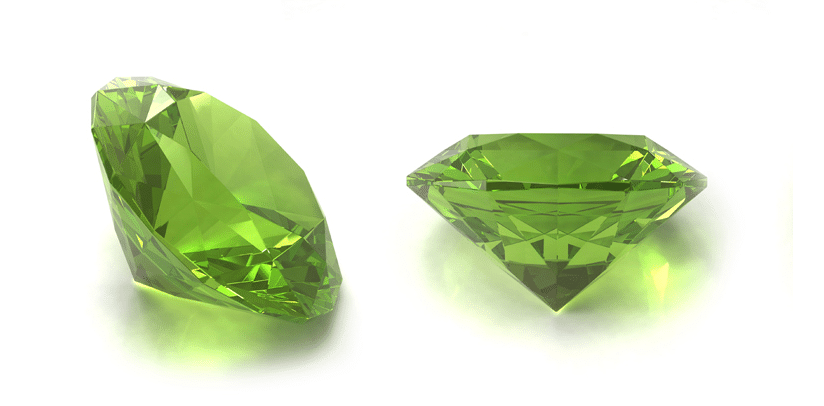
August’s birthstone peridot is alive with brilliance and light. A sight to behold when you get a chance to see a high-quality specimen. Known by the Romans as the “evening emerald”. Only occurring in limited shades of green. Some stones display hints of brownish and olive green but most commonly deliver a beautiful Springtime yellow-green. However, the most prized color is transparent grass green.
Peridot is pronounced, pair-uh-doe. And, the plural form is peridot, not peridots.
In addition, peridot is the stone for the sixteenth wedding anniversary.
To check out other birthstones, see our Official Birthstone List.
Img Source: Creative Jewelers NM
Peridot Meanings
A host of qualities are still associated with the peridot today:
- It is said to have magical and healing properties.
- It will bring power, influence, dignity, prosperity, good fortune, and love to one who wears it.
- One tradition says that people born in August will not find love or a faithful partner unless they wear the gem.
- It is believed to protect one from envy; ward off nightmares, fear, and depression; increase the effectiveness of medicine; improve speech.
The Origins of Peridot
With only two exceptions, all gemstones are formed in the Earth’s outside crust. Those two exceptions, peridot and diamond form deep within our planet’s mantle. From molten rock, peridot comes to the surface through earthquakes and volcanoes. Volcanic rock called basalts, rich in iron is where miners often find peridot. In very rare instances, peridot comes from meteorites. Fayalite and forsterite are the two minerals that make up Olivine. Peridot being the gem variety of Olivine. The characteristic yellow-green color comes from iron while nickel and chromium give it extra intensity.
Quality of Peridot From Different Regions
Firstly, about 80% of the world’s peridot comes from Arizona. It’s usually of lesser quality but definitely more affordable. However, the finest peridot is usually mined in Burma (Myanmar). And more recently, in Pakistan. Since the time of Cleopatra, millions of dollars of the finest peridot have been produced on the island of Zabargad in the Red Sea. Unfortunately, it is no longer in active production.
Moreover, peridot occurs as large crystals only rarely and only in a few places on Earth:
- Myanmar (Burma)
- Pakistan
- the island of Zabargad
- Finland
Within certain types of solidified molten lava occur veins or pockets lined with these large peridot crystals.
Known for Its Fire
Because they could still see peridot’s green light in the evening, Romans called it “evening emerald”. Obviously, with ancient exalted names like Egypt’s “Gem of the Sun” and the Roman’s “evening emerald”, you get the idea that peridot is known for its bright light or fire. The more light emanating from that bright green color. The more desirable and costly the peridot.
So, if you’d like to see examples of beautiful, high-quality peridot, come to Copeland’s. We’d love to share the gem world with you!
Historically Speaking
Because of its volcanic origin, peridot is said to represent the tears of Pele, the Hawaiian goddess of volcanoes and fire.
History reminds us that the ancient Egyptians mined this green stone they revered as the “Gem of the Sun”. Plus, it was Cleopatra’s favorite gemstone. In addition, Pliny wrote about the green stone from Zagbargad Island in 1500 B.C. This “Gem of the Sun” was mined for over 3,500 years on Zabargad Island in the Red Sea. The gem we’re referring to is August’s birthstone Peridot.
At times, labeled as topaz, the gem was often confused with other stones as well. Famous gemstones like Cleopatra’s renowned emerald collection are currently being debated. Many historians now believe they were peridot. In addition, this confusion with emeralds continued into medieval times. As an example, the fantastic 200 ct. gemstones of the Shrine of the Three Holy Kings in the Cologne Cathedral in Germany. For hundreds of years, these stones too were mistakenly believed to be emeralds.
We now know, they are indeed peridot!
